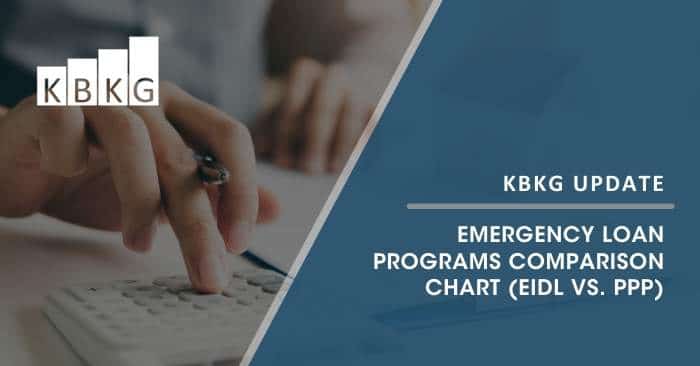Updated April 7, 2020 – There are lots of questions about business loan options in light of the Coronavirus Aid, Relief, and Economic Security (CARES) Act and national emergency declaration. The Small Business Administration (SBA) is offering Economic Injury Disaster Loan Assistance (EIDL), while the CARES Act includes a Paycheck Protection Program (PPP). Many are left wondering which program makes the most sense for their business needs.
Below is a comparison chart to help identify the best course of action. Businesses should work closely with their CPA or tax preparer to determine what makes the most sense for their unique situation.
KBKG is providing this proprietary chart solely as a resource for our tax preparer contacts. We do not offer any services in this area.
Please note that this chart is not exhaustive and will likely be updated on a regular basis to reflect recent changes. Please refer back to this chart for the latest updates.
| EIDL | PPP |
|---|---|
| Who is the lender? | |
| The SBA | A Bank that is already an SBA lender or any federally insured depository institution, federally insured credit union, and Farm Credit System institution that is participating. Other regulated lenders will be available to make these loans once they are approved and enrolled in the program. |
| When can I apply? | |
| Now |
|
| Who can apply? | |
|
|
|
| What are the affiliation rules? | |
| Affiliation rules become important when SBA is deciding whether a business’s affiliations preclude them from being considered “small.” Generally, affiliation exists when one business controls or has the power to control another or when a third party (or parties) controls or has the power to control both businesses. | Affiliation rules have been waived for:
|
| What is the maximum amount of the loan? | |
| The maximum loan size is $2 million. Applicants who apply for this loan may request an advance of up to $10,000 from the SBA. The advance will be distributed within 3 days. Applicants are not required to repay this advance if they not qualify. | The maximum loan size is $10 million. The calculation is as follows:
Payroll includes: Payroll excludes: |
| What is the annual interest rate? | |
| 3.75% for businesses, 2.75% for non-profits | 1% for the unforgiven portion of the loan |
| What is the term of the loan? | |
| Up to 30 years | 2 years for the unforgiven portion of the loan |
| When is the first loan payment due? | |
| One year after the loan origination date (interest is accrued during the deferment) | At least six months after the loan origination date (interest is accrued during the deferment) |
| What can we use the loan for? | |
| Financial obligations and operating expenses that could have been met had the disaster not occurred | Permitted costs which are:
|
| Is there a loan forgiveness program? | |
| No | Yes – calculated as the amount spent on Permitted costs by the borrower during an 8-week period (the “Covered Period”) after the origination date of the loan |
| What reduces the forgiveness? | |
| N/A | The amount forgiven is reduced based on failure to maintain the average number of full-time equivalent employees versus the period from either February 15, 2019, through June 30, 2019, or January 1, 2020, through February 29, 2020, as selected by the borrower. The amount forgiven is also reduced to the extent that compensation for any individual making less than $100,000 per year is reduced by more than 25% measured against the most recent full quarter. Reductions in the number of employees or compensation occurring between February 15, 2020, and 30 days after enactment of the CARES Act will generally be ignored to the extent that reductions are reversed by June 30, 2020. Forgiven amounts will not constitute cancellation of indebtedness income for federal tax purposes. |
| How do I get forgiveness? | |
| N/A | You must apply through your lender for forgiveness on your loan. In this application, you must include:
|
| What collateral is required? | |
| The SBA will place a UCC lien against the assets of the business | No collateral is required from either the business or its owners |
| Is a personal guarantee required? | |
| Yes, for loans > $200,000, owners of > 20% of the business, managing members of LLCs, managing partners of LPs. However, no liens will be taken against real estate owned by the guarantor | No. |
| Do I need to have filed my 2019 Taxes to apply? | |
| No, 2019 Taxes do not have to be filed prior to applying for the loan. However, businesses will be asked to submit IRS form 4506T, which provides the SBA with access to historical tax returns | Will depend on the lender |
Note – This information is supplied to inform our clients and partners. However, the exact terms of loans are determined solely by the lender(s) and KBKG can make no representation as to the accuracy or completeness of any information contained herein.
Sources:
https://disasterloan.sba.gov/
https://www.congress.gov/


